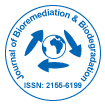Conference Proceeding
Biodegradation of Free Cyanide Using Bacillus Sp. Consortium Dominated by Bacillus Safensis, Lichenformis and Tequilensis Strains: A Bioprocess Supported Solely with Whey
| Lukhanyo Mekuto, Vanessa Angela Jackson and Seteno Karabo Obed Ntwampe* | |
| Faculty of Applied Sciences, Department of Agriculture and Food Science - Biotechnology, Cape Peninsula University of Technology, Cape Town, South Africa | |
| Corresponding Author : | Seteno Karabo Obed Ntwampe Faculty of Applied Sciences Department of Agriculture and Food Science-Biotechnology Cape Peninsula University of Technology, Cape Town, South Africa Tel: +27 21 460 9097 Fax: +27 21 460 3282 E-mail: NtwampeS@cput.ac.za |
| Received November 09, 2013; Accepted December 16, 2013; Published December 22, 2013 | |
| Citation: Mekuto L, Jackson VA, Ntwampe SKO (2013) Biodegradation of Free Cyanide Using Bacillus Sp. Consortium Dominated by Bacillus Safensis, Lichenformis and Tequilensis Strains: A Bioprocess Supported Solely with Whey. J Bioremed Biodeg S18:004. doi:10.4172/2155-6199.S18-004 | |
| Copyright: © 2013 Mekuto L, et al. This is an open-a ccess article distributed under the terms of the Creative Commons Attribution License, which permits unrestricted use, distribution, and reproduction in any medium, provided the original author and source are credited. | |
Related article at Pubmed Pubmed  Scholar Google Scholar Google |
|
Abstract
Several bacterial species (n=13) were isolated from electroplating wastewater to assess their ability to biodegrade free cyanide (F-CN). A mixed culture mainly dominated by Bacillus sp (Bacillus safensis, Bacillus lichenformis and Bacillus tequilensis) was cultured in nutrient broth for 48 hours at 37°C, to which F-CN as KCN (200 to 400 mg CN-/L) was added in order to evaluate the species ability to tolerate and biodegrade the cyanide. In nutrient broth, the microorganisms were able to degrade 131(65.5%) and 177 (44.3%) mg CN-/L in cultures containing 200 and 400 mg CN-/L over a period of 8 days, respectively. Subsequently, cultures were supplemented solely with agrowaste extracts, i.e. Ananas comosus extract (1% v/v), Beta vulgaris extract (1% v/v), Ipomea batatas extract (1% v/v), spent brewer’s yeast (1% v/v) and whey (0.5% w/v), as the primary carbon sources in 200 and 400 mg CN-/L cultures. The bacterial species were able to degrade F-CN in cultures that were supplemented with whey, whereby 179 (89.5%) and 239 (59.75%) mg CN-/L was biodegraded from 200 and 400 mg CN-/L cultures, respectively.

 Spanish
Spanish  Chinese
Chinese  Russian
Russian  German
German  French
French  Japanese
Japanese  Portuguese
Portuguese  Hindi
Hindi 
